
Case Overview
- Location: Atlantic Ocean, off of the coast of Brazil
- Date: June 1, 2009
- Aircraft: Airbus A330
Motley Rice aviation attorneys represent victims and their families related to the tragic crash of Air France Flight 447, which disappeared from radar and crashed into the Atlantic Ocean on June 1, 2009, with 216 passengers and 12 crew members.
About the Air France Flight 447 Crash
On June 1, 2009, at approximately 11:14 p.m. local Brazilian time, air traffic control lost contact with Air France Flight 447 and the plane disappeared from radar. Five days later, the bodies of several crash victims were found about 600 miles off the northeast coast of Brazil near the San Pedro and Sao Paulo archipelago. Hundreds of pieces of wreckage were recovered during the next few weeks, but the aircraft’s black boxes, which contain the flight data recorder and cockpit voice recorder, were not recovered until May 2011, almost two years later.
According to the final report on the incident by France’s BEA (Bureau d'Enquêtes et d'Analyses pour la Sécurité de l'Aviation Civile, the equivalent of the U.S. National Transportation Safety Board), the crash was due to a number of temporary inconsistencies that caused the autopilot to disconnect and the crew’s poor response to the situation, ultimately forcing the plane into an aerodynamic stall from which it did not recover. The BEA’s report states that the incident resulted from the following succession of events:
- A temporary inconsistency between airspeed measurements, likely caused by ice covering the Pitot tubes on the wings that measure airspeed, caused the autopilot to disengage.
- The flight path destabilized due to inappropriate control inputs.
- The crew did not link the loss of airspeed with the appropriate procedure to repair the situation.
- The pilot not flying (PNF) did not identify the plane’s deviation from the flight path until later, and the pilot flying (PF) did not correct the deviation sufficiently.
- The crew did not identify the plane’s approach-to-stall, did not respond to the situation immediately, and exited the flight envelope.
- On failing to diagnose the stall situation, they did not provide the necessary inputs that would have allowed the plane to recover.
Read a synopsis of the flight-data recorders transcript.
Flight 447’s Pitot Tubes Were Not Replaced
In September 2007, Airbus recommended that airlines replace the Thales SA speed sensors, known as pitot tubes, on A320, A330 and A340 Airbus models. The older pitot tubes were at risk of malfunctioning and therefore were to be replaced with a newer, improved model. On April 27, 2009, Air France began replacing the pitot tubes on its fleet of the Airbus A330 model and expected to complete those replacements in "the coming weeks."
A pitot tube is an L-shaped metal tube which is attached to the wing of an aircraft and is heated in order to prevent icing. If a pitot tube failed, iced-over or became blocked, an airspeed sensor could fail, thus causing the aircraft's controlling computer to either accelerate or decelerate inappropriately. Flight 447’s pitot tubs had not yet been replaced.
The Investigation of Air France Flight 447
As an international flight, the aftermath of the flight's disappearance is governed by international treaty law, including the Warsaw Treaty and Montreal Conventions. These treaty provisions provide that the airline is automatically liable and responsible for all actual damages and losses sustained by Air France passengers. The victims' attorneys do not have to prove the airline's liability, but only the damages to the victims and their families. Air France, France and Brazil have removed caps on victims' actual damages.
The French BEA and the United States National Transportation Safety Board (NTSB) handled the investigation. The United States NTSB was involved because the engines on the aircraft were General Electric turbofan engines, designed and manufactured in the United States.

